非谓语动词解题方法
非谓语动词的解题思路
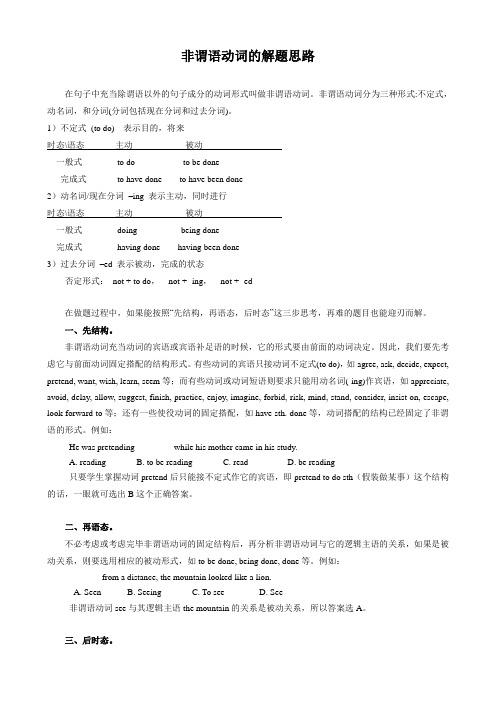
非谓语动词的解题思路在句子中充当除谓语以外的句子成分的动词形式叫做非谓语动词。
非谓语动词分为三种形式:不定式,动名词,和分词(分词包括现在分词和过去分词)。
1)不定式(to do) 表示目的,将来时态\语态主动被动一般式to do to be done完成式to have done to have been done2)动名词/现在分词–ing 表示主动,同时进行时态\语态主动被动一般式doing being done完成式having done having been done3)过去分词–ed 表示被动,完成的状态否定形式:not + to do,not + -ing,not + -ed在做题过程中,如果能按照“先结构,再语态,后时态”这三步思考,再难的题目也能迎刃而解。
一、先结构。
非谓语动词充当动词的宾语或宾语补足语的时候,它的形式要由前面的动词决定。
因此,我们要先考虑它与前面动词固定搭配的结构形式。
有些动词的宾语只接动词不定式(to do),如agree, ask, decide, expect, pretend, want, wish, learn, seem等;而有些动词或动词短语则要求只能用动名词(-ing)作宾语,如appreciate, avoid, delay, allow, suggest, finish, practice, enjoy, imagine, forbid, risk, mind, stand, consider, insist on, escape, look forward to等;还有一些使役动词的固定搭配,如have sth. done等,动词搭配的结构已经固定了非谓语的形式。
例如:He was pretending ________ while his mother came in his study.A. readingB. to be readingC. readD. be reading只要学生掌握动词pretend后只能接不定式作它的宾语,即pretend to do sth(假装做某事)这个结构的话,一眼就可选出B这个正确答案。
非谓语动词
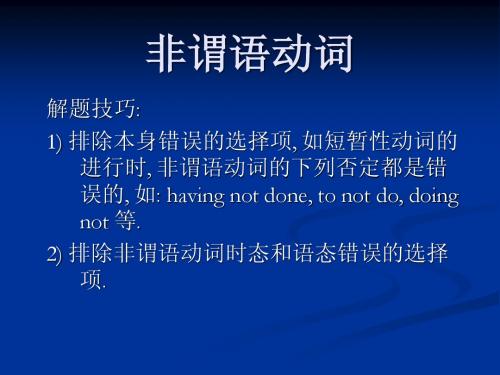
1. 语态的判断: 1) 在 “be + adj.” 或 “SVOC” 结构中,后面 所跟的不定式常用主动语态. 2) 习惯上用 to let (出租), to blame (责怪) 等主动形式表被动意义. 2. 时态的判断 不定式的完成式用在was/were, planned, intended, meant, hoped, wished等之后,表示 事实上并未实现的行为或plan, intend, wish, hope, mean等动词的过去完成式与不定式一般式 连用,也可以表示事实上并没有实现的行为.
பைடு நூலகம்
Ⅳ. 动名词的逻辑主语 表示方法: 人称代词的所有格或有生命物体 名词的’s/s’的所有格 例句6: I had to postpone ____ to his plan to a later date. A. me listening B. my listening C. myself listening D. mine listening 如果逻辑主语是没有生命的名词,那通常用 普通格; 如果是有生命的,一般用所有格; 但 是做介词宾语时, 也可以用普通格.
例如:I intended to have finished it, but I failed at last. (没有实现) I had intended to finish it, but I failed. (没有实 现) 3. 不定式做复合谓语的一部分 be said, be reported, be supposed, be believed, be known, be sorry, seem等之后经常跟不定式. 4. 同时涉及时态和语态时, 应该先判断语态. 例如: He is supposed to have left for Italy last week.
非谓语的解题步骤或思路

非谓语的解题步骤或思路(1)先判断空格部分所需的是主句,从句还是非谓语动词。
独立的句子,从句或非谓语独立的句子加句号,分号或破折号的话,后再加一个独立的句子。
独立的句子,(逗号)有and,but, so 等词加独立的句子。
(2)再根据主句的主语,来判断主动或被动;(3)接下来再判断时态,(4)如果是否定的话,not一定要放在非谓语的前面(5)一定不要忘记主语一致的原则,如果不一致的话,要把非谓语的独立主语加上。
非谓语常见的位置,或在句子中所担当的成分(1)非谓语动词短语,+ 主句或者是主句,非谓语动词短语这时的非谓语动词短语起到状语的作用例如:influenced by the growing interest in nature, more people enjoy outdaoor activities.在这种情况下,首先,找出主句的主语,然后以主句的主语为出发点,来判断非谓语动词是主动还是被动,如果已有的非谓语动词的主语和主句主语不一致,还要考虑独立主格结构,也就是把非谓语动词的自己的主语加上去:例如:All flights having been cancelled , they decided to takethe train.其次,把非谓语动词和主句的动词比较,看是否同时发生还是有明显的先后。
(2)跟在介词,动词或某些形容词的后面固定搭配只接动词-ing形式而不接不定式作宾语的动词有:admit 承认appreciate 感激avoid 避免put off推迟keep 保持consider 考虑delay/ postpone耽搁dislike 嫌恶resist 抵制mention 提及enjoy 喜欢escape 避免excuse 原谅practice 练习mind介意fancy想不到feel like 意欲finish 完成risk 冒险include 包括forgive 原谅give up 放弃suggest 建议miss 逃过imagine 想象can’t help 情不自禁involve 需要can’t stand 无法忍受understand 理解常见的带介词to的短语:be used to 习惯be related to 与……有关get down to 着手做contribute to 贡献put one’s mind to全神贯注于give rise to 引起be equal to 胜任devote oneself to 献身于lead to 导致be opposed to 反对look forward to 盼望object to 反对stick to 坚持pay attention to 注意(3)介词后一定要加动词的-ing 形式;(4)跟在名词后面做定语时,一般不用having done/ having been done 结构(5)放在句首做主语,一般用动词的ing 和to do …特殊的非谓语短语Generally speaking 一般来说Considering …. 考虑到,鉴于Time/weather permitting 时间、天气允许的话Taking …into account 考虑到Taking …into consideration 考虑到Provided …假如Providing…假如Suppose…假如Supposing…假如Juding from/ by…根据…判断Given sth 假如,如果;鉴于,考虑到Given that…假如,如果;鉴于,考虑到。
英语语法:非谓语动词,重点和解题方法
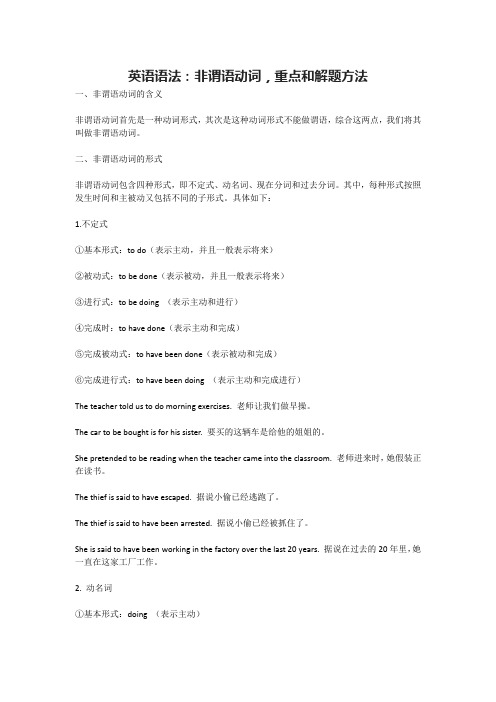
英语语法:非谓语动词,重点和解题方法一、非谓语动词的含义非谓语动词首先是一种动词形式,其次是这种动词形式不能做谓语,综合这两点,我们将其叫做非谓语动词。
二、非谓语动词的形式非谓语动词包含四种形式,即不定式、动名词、现在分词和过去分词。
其中,每种形式按照发生时间和主被动又包括不同的子形式。
具体如下:1.不定式①基本形式:to do(表示主动,并且一般表示将来)②被动式:to be done(表示被动,并且一般表示将来)③进行式:to be doing (表示主动和进行)④完成时:to have done(表示主动和完成)⑤完成被动式:to have been done(表示被动和完成)⑥完成进行式:to have been doing (表示主动和完成进行)The teacher told us to do morning exercises. 老师让我们做早操。
The car to be bought is for his sister. 要买的这辆车是给他的姐姐的。
She pretended to be reading when the teacher came into the classroom. 老师进来时,她假装正在读书。
The thief is said to have escaped. 据说小偷已经逃跑了。
The thief is said to have been arrested. 据说小偷已经被抓住了。
She is said to have been working in the factory over the last 20 years. 据说在过去的20年里,她一直在这家工厂工作。
2. 动名词①基本形式:doing (表示主动)②被动式:being done(表示被动)③完成式:having done(表示主动和完成)④完成被动式:having been done(表示被动和完成)Travelling in space by ordinary people will be common in the future. 在未来,普通人在太空旅行将会是普遍的事情。
非谓语动词解题五步曲
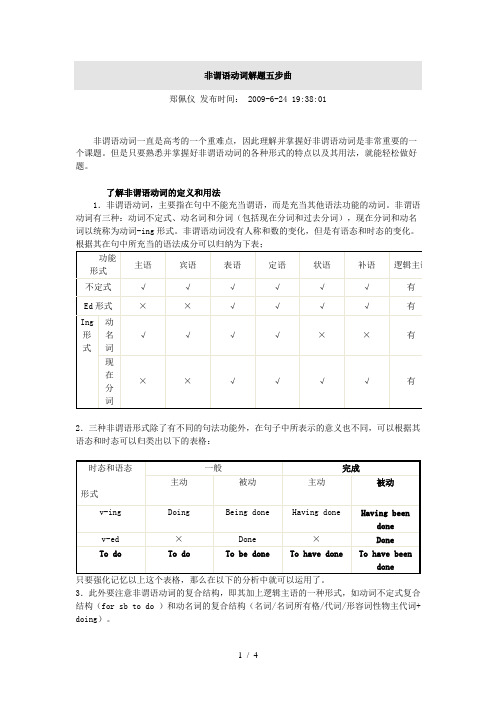
非谓语动词解题五步曲郑佩仪发布时间: 2009-6-24 19:38:01非谓语动词一直是高考的一个重难点,因此理解并掌握好非谓语动词是非常重要的一个课题。
但是只要熟悉并掌握好非谓语动词的各种形式的特点以及其用法,就能轻松做好题。
一、了解非谓语动词的定义和用法1.非谓语动词,主要指在句中不能充当谓语,而是充当其他语法功能的动词。
非谓语动词有三种:动词不定式、动名词和分词(包括现在分词和过去分词),现在分词和动名词以统称为动词-ing形式。
非谓语动词没有人称和数的变化,但是有语态和时态的变化。
根据其在句中所充当的语法成分可以归纳为下表;2.三种非谓语形式除了有不同的句法功能外,在句子中所表示的意义也不同,可以根据其语态和时态可以归类出以下的表格:只要强化记忆以上这个表格,那么在以下的分析中就可以运用了。
3.此外要注意非谓语动词的复合结构,即其加上逻辑主语的一种形式,如动词不定式复合结构(for sb to do )和动名词的复合结构(名词/名词所有格/代词/形容词性物主代词+ doing)。
Eg. It is hard for Mary to get up early.句中It是形式主语,而for Mary to get up early真正的主语,而其中Mary是get up 的逻辑主语。
4.非谓语动词的否定式也是常考的项目,要认清否定形式,非谓语动词的否定都应将not 放在非谓语动词之前,但如该谓语形式前有逻辑主语,则要置于逻辑主语之后,如What is the reason for your not going home..5. 熟记各种非谓语动做相同成分的区别以及一些固定搭配三种非谓语形式在很多情况下都可以做相同的成分,但根据句意和语法结构分析可以区别并判断,如动名词和不定式同时可以做宾语词倾向指经常性发生的事情,而不定式指一次性的事情,如I like playing football very much, but I don’t like to play now.此外还有一些固定搭配,有些动词只能接动名词做宾语,如suggest, risk, look forward to 等;有些动词只接不定式做宾语,如seem, expect, want等;有些动词既可以接动名词又可以接不定式做宾语,如stop, remember, begin等,但句意稍有区别;有些动词可接动名词,且有主动表被动的作用,如want, need, require等。
非谓语动词解题三原则

非谓语动词解题三原则1、查看句子是否缺少谓语动词,以判断是否使用非谓语动词。
(高中学习中,一般情况下同一个句子不能出现两个谓语,如果句子有谓语则选择非谓语)2、判断语态,根据动作执行者和承受者来判断是使用主动还是被动语态)3、判断时态,根据动作的先后关系等,判断应该使用的时态。
高中英语语法非谓语动词解题技巧一. 非谓语动词的句子结构分析技巧1_____many times , but he still couldn't understand it . 2. _____many times , he still couldn't understand it .A.Having been toldB. ToldC. He was toldD. Though he had been told分析:句1. 用连词but 引导并列句子,因此,前面与后句一样也是个独立句子成分,故选C。
句2. 句中用逗号隔开,且无连词引导,因此,前面不是句子结构,只是句子的一个成分,故选A,用非谓语动词作状语。
句子结构练习3. ______to the left , you'll find the post office .4. If you _____to the left , you'll find the post office .5. ______to the left , and you'll find the post office . A. Turning B. To turn C. Turn D. Turned 答案ACC二. 非谓语动词的逻辑主语分析技巧确定要选非谓语动词之后,第二步要分析其逻辑主语。
非谓语动词虽不能作谓语,但仍具有动词特点,其逻辑上的动作执行者就叫做逻辑主语。
非谓语动词作状语时,其逻辑主语须和句子的真正主语一致。
若不一致,则须加上自己的逻辑主语。
First ____ to the market, these products enjoyed great success.A. introducingB. introducedC. introduceD. being introduced分析: 非谓语动词的逻辑主语是: these products, 与句子的主语一致, 故选B1._______no buses , we had to walk home.2. ______Sunday, I shall have a quiet day at home .A. There beingB. It wereC. There wereD. It being分析:句1. 表示“没有公共汽车”,应用“there be”结构,即逻辑主语是“there”,故选A 。
非谓语动词解题方法.

5. I have a lot of readings ________ before the end of this term. A.completing B.to complete C.completed D.being completed
【解析】 B 根据动词短语have sth. to do,且本句有时 间状语the end of this term,选B。
2.______ in thought, he almost ran into the car in front of him. A. Losing B. Having lost C. Lost D. To lose
解析:此题考查固定短语搭配 be lost in thought “陷入沉思 故选C. *与此相类似的短语还有: be interested in, be dressed in, be satisfied with, be married to sb, be determined to do
A 3. ________to the left , you'll find the post office . C 4. If you _______to the left , you'll find the post office . C 5. ________to the left , and you'll find the post office . A. Turning B. To turn C. Turn D. Turned 句3:句中用逗号隔开,且无连词引导,因此,前面不是 句子结构,只是句子的一个成分,故选A,用非谓语动词 作状语。 句4. 前面用if 引导从句,故选C ,构成从句谓语。 句5:用连词but 引导并列句子,因此,前面也是个独立 句子成分,故选C。
例析非谓语动词解题步骤

非谓语动词解题技巧

非谓语动词练习一.非谓语题的解题总方法与思路:1. 辨别―谓与非谓‖1.)先看四个答案:如果四个答案分别为动词原形、不定式、现在分词、过去分词等情况,那么这个题多半是非谓语动词题。
2.)看符号:中间有个逗号,末尾有个句号(有时中间没有逗号);3.)看有没有连接词(引导词)。
如果用逗号隔开的两个部分都没有连接词的话,一部分是句子时,那么另一部分就一定是非句子,而非句子里的动词就是非谓语动词。
2. 找逻辑主语3. 定语态:如果本句的主语(或动词自带的逻辑主语)与它是逻辑上的主谓关系,那么答案一般用Ving形式;如果本句的主语(或动词自带的逻辑主语)与它是逻辑上的动宾关系(被动关系),那么答案一般用V ed形式。
4. 定时态:如果非谓语的动作比谓语先(或先很久)发生,那么非谓语动词要用完成式(to havedone/to have been done/ having done/ Having been done),否则我们要用非谓语的一般式(to do / to be done / doing / being done / done)。
二.非谓语动词可能出现的考查点及易错点:1)在“句子, and/or/but +句子”的并列句结构中,可能会考查“以动词原形开头”的祈使句,四个答案表面上象非谓语,其实考查的是谓语。
1.______hard and you will succeed in the exam.2.______hard or you will fail in the exam.3.______hard , you will succeed in the exam.A. StudyB. T o studyC. S tudyingD. Studied2)在“句子,非句子”结构中,非句子部分用非谓语:4. The teacher devoted his life to his career, ______ most of his students successful in study.A. makeB. to makeC. makingD. made3)在“非句子,句子”结构中,非句子部分用非谓语:5. _________with children, I know what is needed most.A. WorkingB. Having workedC. WorkedD. T o work4) 在“with + 宾语+ 宾语补足语”结构中,宾语补足语可能用非谓语动词:6. With her baby _______ on her back, the woman was cleaning the rich man’s house.A. sleepB. sleptC. to sleepD. sleeping7. With his hair _______ like a role in the film, the boy felt very cool.A. cutB. to be cutC. cuttingD. to cut5)在drive/leave/keep/make/have/let/get/find/hear…等使让动词或感观动词后面作宾语补足语时,也可能用非谓语动词。
非谓语动词解题三步曲

GUAN GDONG JIAO YU GAO ZHONG广东教育·高中2020年第12期非谓语动词是高中语法的重点和难点,是阅读理解和书面表达的必备基础,也是语法填空的必考点,每年每套题中有1-3小题。
面对非谓语动词,考生经常感到棘手,得分率不高。
其实,从近3年的高考真题来看,高考对非谓语动词的考查非常简单,仅限于考查to do,doing,done 的基本形式。
也就是说,考生只要掌握非谓语动词的三种最基本的形式,题目便迎刃而解。
为帮助考生突破非谓语动词,我们可以用“三步曲”解决非谓语动词。
第一步,分析句子结构,辨别谓语与非谓语。
根据句子的结构,英语句子可分为简单句、并列句和复合句。
简单句只含有一个主谓结构。
并列句是由并列连词and,or,but,so 等连接的两个或两个以上分句而构成的句子,即S1+并列连词+S2。
复合句是由“主句+引导词+从句(定语从句,状语从句,名词性从句)”构成的句子。
根据以上句子成分分析可知,如果一个句子已经有谓语动词,而且空格前没有并列连词或从属连词,一般为非谓语动词。
如:1.(2020全国Ⅰ卷)Chinese researchers hope to use the in 鄄struments on board Chang ’e-4________(find)and study areas of the South Pole-Aitken basin.2.(2020全国Ⅱ卷)They represent the earth __________(come)back to life and best wishes for new beginnings.3.(2020全国Ⅱ卷)They make great gifs and you see them many times ________(decorate)with red envelopes and mes 鄄sages of good fortune.4.(2020山东卷)The 80,000objects collected by Sir Hans Sloane,for example,________(form)the core collection of the British Museum which opened in 1759.分析:第1~3题谓语动词分别是hope,represent,see ,空格前均无连词,因此,括号中所给词均为非谓语动词。
语法填空非谓语动词解题技巧

语法填空非谓语动词解题技巧
以下是 6 条关于语法填空非谓语动词解题技巧:
1. 哎呀,你知道吗,找逻辑主语超重要的呀!就像“Hearing the news, she cried.”这里“she”就是“hearing”的逻辑主语呀,明白了这一点,做题不就清晰多啦?
2. 嘿呀,要注意时态呀!比如“Having finished the work, he went home.”,“finished”表示完成的动作在前,这不是很好理解吗?
3. 哇塞,看清楚与谓语动词的先后顺序啊!就像“Seen from the top of the hill, the city looks beautiful.”和“Seeing the city from the top of the hill, I feel excited.”,一个是被动一个是主动,先后顺序可不一样呢,你不会搞混吧?
4. 哎呀呀,别忘了固定搭配呀!“be used to doing”“look forward to doing”等等,这些可都是解题关键呀,可别掉坑里哟!
5. 呀,分析句子成分也很关键哦!比如“She wants to have her hair cut.”,“to have”是作宾语呀,清楚了吗?
6. 哈哈,熟悉那些常见用法呀!像表示目的用“to do”,表示伴随用“doing”,这不就可以快速判断啦!
我的观点结论就是:只要掌握好这些技巧,非谓语动词的语法填空题就能迎刃而解啦!。
非谓语动词解题方法
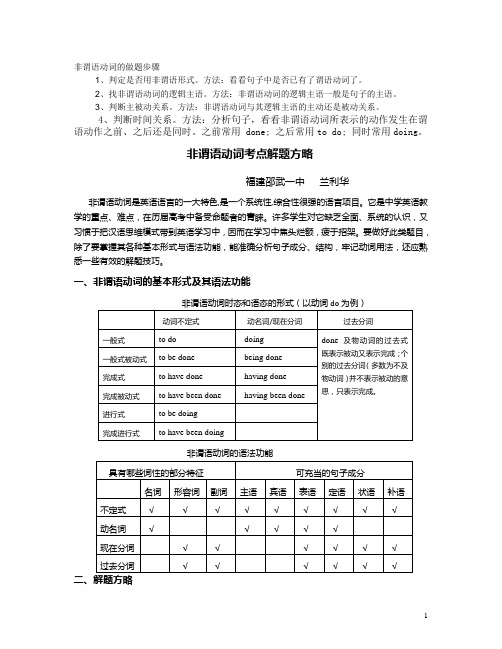
非谓语动词的做题步骤1、判定是否用非谓语形式。
方法:看看句子中是否已有了谓语动词了。
2、找非谓语动词的逻辑主语。
方法:非谓语动词的逻辑主语一般是句子的主语。
3、判断主被动关系。
方法:非谓语动词与其逻辑主语的主动还是被动关系。
4、判断时间关系。
方法:分析句子,看看非谓语动词所表示的动作发生在谓语动作之前、之后还是同时。
之前常用 done; 之后常用to do; 同时常用doing。
非谓语动词考点解题方略福建邵武一中兰利华非谓语动词是英语语言的一大特色,是一个系统性,综合性很强的语言项目。
它是中学英语教学的重点、难点,在历届高考中备受命题者的青睐。
许多学生对它缺乏全面、系统的认识,又习惯于把汉语思维模式带到英语学习中,因而在学习中焦头烂额,疲于招架。
要做好此类题目,除了要掌握其各种基本形式与语法功能,能准确分析句子成分、结构,牢记动词用法,还应熟悉一些有效的解题技巧。
一、非谓语动词的基本形式及其语法功能二、解题方略步骤一分析句子结构,确定答案范围一个句子中通常不能有两个(以上)的谓语动词,除非动词是并列谓语或多个谓语动词是分别出现在主从复合句或并列句中。
根据这个语法规则,我们可以确定答案该用谓语动词还是非谓语动词。
例1 Who could have imagined such a sweet-tempered girl as Alice ______ such a thing!A. doingB. to doC. will doD. does解析:句中已有谓语动词imagined , 且句子不属于主从复合句或并列句,故空格处不可再填谓语动词,排除C、D, 再结合考虑动词用法imagine (sb) doing, 得出答案为A.例2 ______ many times, but he still couldn’t understand it.A. Having been toldB. Though he had been toldC. He had been toldD. Having told解析: 从bu t 得知逗号前后为表示转折关系的并列句, 逗号前的内容为一个句子,所以空格处不能是非谓语动词, 排除 A 、D, 又因为though和but不能同用,故答案为C.步骤二多角度考虑确定非谓语动词的具体形式1.非谓语动词的否定形式not均放其前例3______ full preparations, we decided to put off the meeting till next week.A. Not being madeB. Having not madeC. Making notD. Not having made解析:根据not的位置可排除B和C, 再根据句意可确定主语we与非谓语动词make之间为主动关系,所以答案为D.2.非谓语动词不同形式之间的区别非谓语动词包括不定式、现在分词、动名词和过去分词,每种形式都具有各自的语法功能和意义。
高考非谓语动词解题方法三步走

非谓语动词解题方法三步走
第一步:(成分判断)判断非谓语动词充当的句子成分
第二步:(语态判断)判断主动、被动语态
第三步:(时态判断)判断非谓语动词的动作与谓语动作的先后关系
具体判断法则
1.非谓语动词充当句子主语(高考近五年未考)
①(成分判断)充当主语——谓语动作发出者
②(语态判断)主被动的选择取决于句子要表达的意思
③(时态判断)
以下为高考常考内容
2.非谓语动词充当句子宾语
①(成分判断)充当宾语——谓语动作承受者
②(语态判断)
③(时态判断)
3.非谓语动词充当句子定语/宾补
①(成分判断)充当定语/宾补——相当于形容词,用来修饰宾语
②(语态判断)
③(时态判断)
4.非谓语动词充当句子状语
①(成分判断)充当状语——相当于副词,用来修饰谓语
②(语态判断)
③(时态判断)
5.(主系表结构中)非谓语动词充当表语形容词
①(成分判断)在“主+系+表”结构中,充当表语形容词
②(语态判断)
③(时态判断)
根据徐磊英语语法总结。
非谓语解题三步法
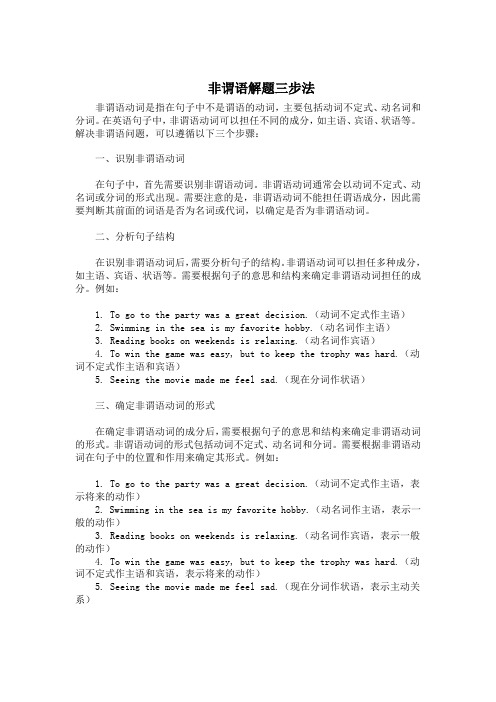
非谓语解题三步法非谓语动词是指在句子中不是谓语的动词,主要包括动词不定式、动名词和分词。
在英语句子中,非谓语动词可以担任不同的成分,如主语、宾语、状语等。
解决非谓语问题,可以遵循以下三个步骤:一、识别非谓语动词在句子中,首先需要识别非谓语动词。
非谓语动词通常会以动词不定式、动名词或分词的形式出现。
需要注意的是,非谓语动词不能担任谓语成分,因此需要判断其前面的词语是否为名词或代词,以确定是否为非谓语动词。
二、分析句子结构在识别非谓语动词后,需要分析句子的结构。
非谓语动词可以担任多种成分,如主语、宾语、状语等。
需要根据句子的意思和结构来确定非谓语动词担任的成分。
例如:1. To go to the party was a great decision.(动词不定式作主语)2. Swimming in the sea is my favorite hobby.(动名词作主语)3. Reading books on weekends is relaxing.(动名词作宾语)4. To win the game was easy, but to keep the trophy was hard.(动词不定式作主语和宾语)5. Seeing the movie made me feel sad.(现在分词作状语)三、确定非谓语动词的形式在确定非谓语动词的成分后,需要根据句子的意思和结构来确定非谓语动词的形式。
非谓语动词的形式包括动词不定式、动名词和分词。
需要根据非谓语动词在句子中的位置和作用来确定其形式。
例如:1. To go to the party was a great decision.(动词不定式作主语,表示将来的动作)2. Swimming in the sea is my favorite hobby.(动名词作主语,表示一般的动作)3. Reading books on weekends is relaxing.(动名词作宾语,表示一般的动作)4. To win the game was easy, but to keep the trophy was hard.(动词不定式作主语和宾语,表示将来的动作)5. Seeing the movie made me feel sad.(现在分词作状语,表示主动关系)。
非谓语动词常用的解题技巧(一)
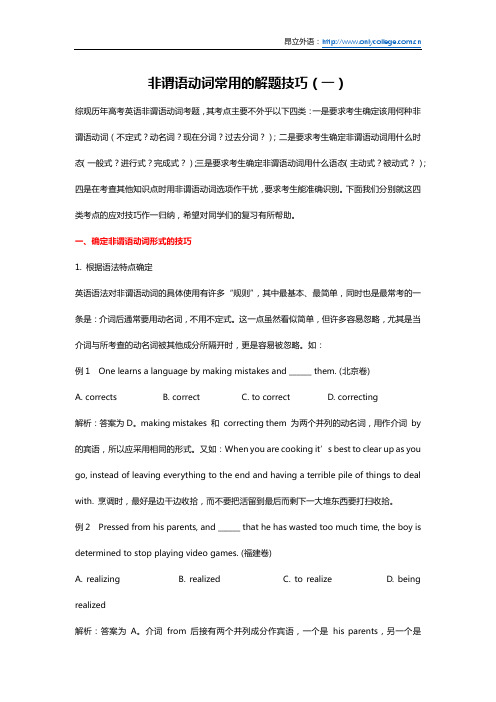
非谓语动词常用的解题技巧(一)综观历年高考英语非谓语动词考题,其考点主要不外乎以下四类:一是要求考生确定该用何种非谓语动词(不定式?动名词?现在分词?过去分词?);二是要求考生确定非谓语动词用什么时态(一般式?进行式?完成式?);三是要求考生确定非谓语动词用什么语态(主动式?被动式?);四是在考查其他知识点时用非谓语动词选项作干扰,要求考生能准确识别。
下面我们分别就这四类考点的应对技巧作一归纳,希望对同学们的复习有所帮助。
一、确定非谓语动词形式的技巧1. 根据语法特点确定英语语法对非谓语动词的具体使用有许多“规则”,其中最基本、最简单,同时也是最常考的一条是:介词后通常要用动名词,不用不定式。
这一点虽然看似简单,但许多容易忽略,尤其是当介词与所考查的动名词被其他成分所隔开时,更是容易被忽略。
如:例1 One learns a language by making mistakes and ______ them. (北京卷)A. correctsB. correctC. to correctD. correcting解析:答案为D。
making mistakes 和correcting them 为两个并列的动名词,用作介词by 的宾语,所以应采用相同的形式。
又如:When you are cooking it’s best to clear up as you go, instead of leaving everything to the end and having a terrible pile of things to deal with. 烹调时,最好是边干边收拾,而不要把活留到最后而剩下一大堆东西要打扫收拾。
例2 Pressed from his parents, and ______ that he has wasted too much time, the boy is determined to stop playing video games. (福建卷)A. realizingB. realizedC. to realizeD. being realized解析:答案为A。
非谓语解题步骤
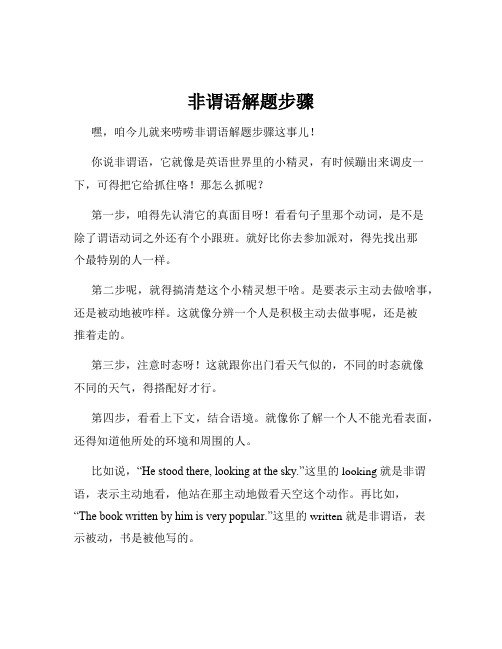
非谓语解题步骤嘿,咱今儿就来唠唠非谓语解题步骤这事儿!你说非谓语,它就像是英语世界里的小精灵,有时候蹦出来调皮一下,可得把它给抓住咯!那怎么抓呢?第一步,咱得先认清它的真面目呀!看看句子里那个动词,是不是除了谓语动词之外还有个小跟班。
就好比你去参加派对,得先找出那个最特别的人一样。
第二步呢,就得搞清楚这个小精灵想干啥。
是要表示主动去做啥事,还是被动地被咋样。
这就像分辨一个人是积极主动去做事呢,还是被推着走的。
第三步,注意时态呀!这就跟你出门看天气似的,不同的时态就像不同的天气,得搭配好才行。
第四步,看看上下文,结合语境。
就像你了解一个人不能光看表面,还得知道他所处的环境和周围的人。
比如说,“He stood there, looking at the sky.”这里的 looking 就是非谓语,表示主动地看,他站在那主动地做看天空这个动作。
再比如,“The book written by him is very popular.”这里的 written 就是非谓语,表示被动,书是被他写的。
咱可不能小瞧这非谓语,它在英语里用处可大着呢!就像一把钥匙,能打开很多复杂句子的大门。
要是没搞懂它,那读起句子来可就像在迷雾里走路,晕头转向的。
想想看,要是你不懂非谓语解题步骤,看到那些复杂的句子岂不是头都大了?但只要咱掌握了方法,就像是有了指南针,能在英语的海洋里畅游啦!所以啊,同学们,可得把这非谓语解题步骤给记牢咯!多练习练习,让这些小精灵都乖乖听话。
别觉得难,就像学骑自行车似的,一开始可能会摔倒,但多练几次不就会了嘛!咱学英语也得有这股子劲儿,不怕困难,勇往直前。
这非谓语解题步骤,就是咱英语学习道路上的重要一步,迈过去了,那英语水平可不得蹭蹭往上涨啊!加油吧,小伙伴们!让我们一起征服这非谓语小精灵,在英语的世界里自由翱翔!。
非谓语动词解题技巧

非谓语动词解题技巧非谓语动词解题技巧什么是非谓语动词?非谓语动词是指不能独立做谓语的动词形式,包括动词不定式、动名词和现在分词、过去分词。
在句子中,非谓语动词通常用来表示时间、原因、结果、方式、条件等。
使用非谓语动词的注意事项使用非谓语动词时,需要注意以下几个方面:1.与主语保持一致:非谓语动词与主语在逻辑上是一致的,即单数主语要与单数形式的非谓语动词搭配,复数主语要与复数形式的非谓语动词搭配。
2.合理使用各种非谓语动词形式:根据句子的语境和语义需求,选择合适的非谓语动词形式。
例如,使用动词不定式表示目的,使用动名词表示原因,使用现在分词表示原因或方式,使用过去分词表示结果等。
3.并列结构中的非谓语动词:当句子中存在并列结构时,要保持各个非谓语动词形式的一致性,即使用相同的非谓语动词形式。
解题技巧下面列举一些解题技巧,帮助你更好地理解和运用非谓语动词。
抓住上下文线索根据句子的上下文线索,判断需要使用哪种非谓语动词形式。
例如,如果句子中出现引导目的的词语,那么通常需要使用动词不定式来表示目的。
分析动词的逻辑关系在有多个动词的复句中,要分析各个动词之间的逻辑关系,确定是否需要使用非谓语动词来表示这种关系。
例如,如果两个动词之间存在因果关系,可以使用动名词来表示原因。
注意谓语动词与非谓语动词的区别在解题时,要注意谓语动词和非谓语动词的区别。
非谓语动词不能独立做谓语,而是与其他动词或名词等搭配使用。
多练习,熟悉用法通过大量练习题,熟悉各种非谓语动词的用法和搭配。
不断积累经验,提高对非谓语动词的理解和运用能力。
总结非谓语动词是我们在英语学习和考试中经常遇到的语法知识点之一。
通过掌握相关的解题技巧,我们可以更好地理解和运用非谓语动词,提高解答问题的效率和准确性。
希望以上的技巧和建议能够帮助到你,在非谓语动词解题中取得更好的成绩!非谓语动词的常见用法和搭配以下是一些常见的非谓语动词用法和搭配:动词不定式•表示目的:in order to / so as to / to + 动词原形–She studies hard to get a good grade.(她努力学习为了得到好成绩。
- 1、下载文档前请自行甄别文档内容的完整性,平台不提供额外的编辑、内容补充、找答案等附加服务。
- 2、"仅部分预览"的文档,不可在线预览部分如存在完整性等问题,可反馈申请退款(可完整预览的文档不适用该条件!)。
- 3、如文档侵犯您的权益,请联系客服反馈,我们会尽快为您处理(人工客服工作时间:9:00-18:30)。
非谓语动词之七大经典原则四大解题步骤一.非谓语动词的七大经典原则原则一:用作目的状语,原则上要用不定式原则二:用作伴随状语,原则上要用现在分词原则三:用作结果状语时,可用-ing或不定式原则四:凡是含有被动意义时,原则上要用过去分词。
原则五:非谓语动词作状语时,其逻辑主语原则上应与主句主语保持一致原则六:强调动作发生在主句谓语动作之前时,原则上要用完成式原则七:用于名词后作定语时,原则是:用不定式,表示动作尚未发生;用-ing,表示动作正在进行;用过去分词,表示动作已经发生,同时表示被动意义原则一:用作目的状语,原则上要用不定式1.When asked why he went there,he said he was sent there _____ for a space flight.A. trainingB. being trainedC. to have trainedD. to be trained2. _____ this cake,you’ll need 2 eggs,175 g sugar and 175 g flour.A. Having madeB. MakeC. To makeD. Making原则二:用作伴随状语,原则上要用-ing.3.As the light turned green,I stood for a moment,not_____,and asked myself what I was going to do.A. movedB. movingC. to moveD. Being moved4. He sat _____ to her ______ the stairs.A. to listen; to climbB. listening; to climbC. listening; climbD. listening; to climbing-ing形式作伴随状语与to do作目的状语的区别:作伴随状语的-ing形式与谓语动词的动作同时发生且前面常常带一逗号;而作目的状语的不定式的动作要比谓语动词的动作后发生前面不能用逗号。
1. Write to the editor, ________ that the editor would be able to help her.(hope )2.She reached the top of the hill and stopped there_________ on a big rock.( rest )3.The secretary worked late into night ,_________ a long speech. ( prepare )4. ___________ warm, we shut all the windows. ( keep )原则三:用作结果状语时,可用-ing或不定式,其原则区别是,一般用-ing,表示一定逻辑的结果,即结果在意料之中。
不定式用作结果状语表示非逻辑的结果,即结果在意料之外。
5. The glass doors have taken the place of the wooden ones at the entrance,_____ in the natural light during the day.A. to letB. lettingC. letD. having let6. Oil prices have risen by 32 percent since the start of the year,_____ a record US$ 57. 65a barrel on April 4.A. have reachedB. reachingC. to reachD. to be reaching7.He hurried to the station, only ______ that the train had left.A. to findB. findingC. foundD. to have found8. He hurried to the booking office only _____ that all the tickets had been sold out.A. to tellB. to be toldC. tellingD. told原则四:凡是含有被动意义时,原则上要用过去分词。
但是,如果所涉及的动作尚未发生,则用不定式的被动式;如果所涉及的动作正在进行,则用-ing的被动式.9.The children talked so loudly at dinner table that I had to struggle _____.A. to be heardB. to have heardC. hearingD. being heard10. At the beginning of class, the noise of desks ______could be heard outside the classroom.A. opened and closedB. to be opened and closedC. being opened and closedD. to open and close11. When she came in, she was surprised to find a stranger _____at the back of the classroom with his eyes_____upon her.A. seating; fixingB. to seat; fixingC.having seated; fixedD. seated; fixed原则五:非谓语动词作状语时,其逻辑主语原则上应主句主语保持一致.12. Faced with a bill for $10,000,_____.A. John has taken an extra jobB. the boss has given John an extra jobC. an extra job has been takenD. an extra job has been given to John13. While watching television,_____.A. the door bell rangB. the doorbell ringsC. we heard the doorbell ringD. we heard the doorbell rings原则六:强调动作发生在主句谓语动作之前时,原则上要用完成式(根据情况可用不定式的完成式或—ing的完成式)14._____ from other continents for millions of years,Australia has many plants and animals not found in any other countries in the world.A.Being separatedB. Having separatedC. Having been separatedD. to be separated15. The manager,_____ it clear to us that he didn’t agree with us,left the meeting room.A. who has madeB. having madeC. madeD. making16.—Li Ming is said ____ abroad. Do you know whathe studied in?country he will study in?he studies in?—Yes, In London.A. to have studiedB. to studyC. to be studyingD. to have been studying 原则七:用于名词后作定语时,原则是:用不定式,表示动作尚未发生;用-ing,表示动作正在进行;用过去分词,表示动作被动、完成。
17.There will be more than three hundred scientistsattending the meeting _____ the day after tomorrow.A. holdB. holdingC. heldD. to be held18. There are hundreds of visitors _____ in front of the Art Gallery to have a look at Van Gogh’s paintings.A. waitedB. to waitC. waitingD. wait19. “Things _____ never come again!”I couldn’t help talking to myself.A. lostB. losingC. to lostD. have lost20. —The last one _____ pays the meal.—Agreed!A. arrivedB. arrivesC. to arriveD. arriving二. 非谓语动词解题四大步骤(一)分析句子结构,辨别“谓语与非谓语”1.______many times , but he still couldn't understand it .2. ______many times , he still couldn't understand it .A. Having been toldB. Being toldC. He had been toldD. Though he was told3. ___a hot day, we’d better go swimming.4. ____ a rainy day ; we decided not to go there.A.IsB. To beC. BeingD. It beingE. It wasF. Been(二)找逻辑主语非谓语动词虽不能作谓语,但仍具有动词特点,其逻辑上的动作执行者就叫做逻辑主语。
1.Walking along the street one day, she saw a little girl running up to her.2.She is reading a book found on the way.3.Most of the artists invited to the party werefrom South Africa.4. Convinced of the truth of the reports, he told his colleagues about it.一般来说,作状语的非谓语动词的逻辑主语是句子的主语;作宾补的非谓语动词的逻辑主语是宾语;作定语的非谓语动词的逻辑主语是被修饰词。
